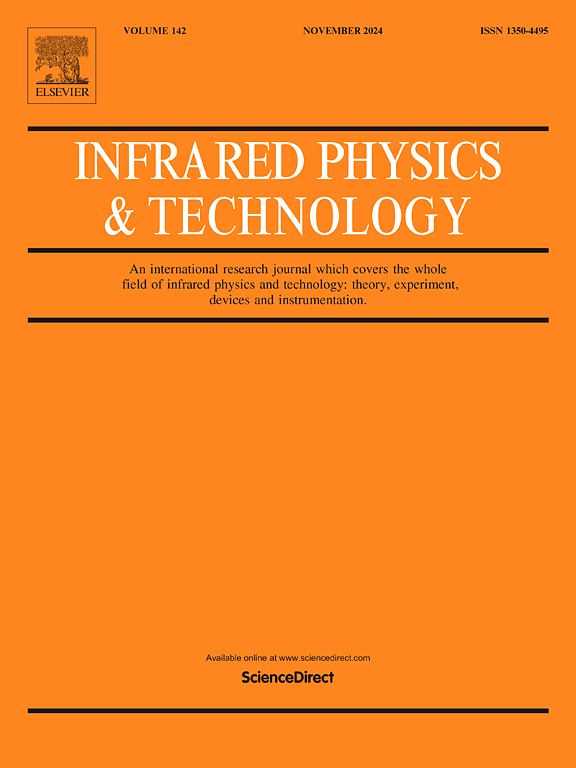A 7 × 1 chalcogenide fiber combiner with high transmission efficiency for mid-infrared high power lasers
IF 3.1
3区 物理与天体物理
Q2 INSTRUMENTS & INSTRUMENTATION
引用次数: 0
Abstract
Fiber combining technology enables the merging of multiple mid-infrared lasers to achieve higher power outputs. However, detailed fabrication methods tailored for mid-infrared applications are rarely reported. In this study, we designed and fabricated a 7 × 1 fiber combiner using infrared chalcogenide glass and evaluated its performance for mid-infrared laser transmission. The fiber combiner consists of three main regions: the input fibers, the taper region, and the taper waist. When the taper ratio is 2 and the taper region length is 15 mm, the combiner demonstrates a uniform optical field distribution and achieves a simulated maximum transmission efficiency of 67.7 %. Experimental results confirmed the simultaneous superposition of laser power across different wavelengths, achieving watts-level output power at a 4.7 μm wavelength for the first time. To address the issue of high Fresnel losses caused by the high refractive index (n = 2.4) of chalcogenide glass at the input and output interfaces of the fiber, we applied a refractive index matching liquid to both ends of the fiber combiner. The average transmission efficiency per port reached 72.84 %, with a maximum transmission power of 2.48 W per single fiber. This advancement surpasses the milliwatt-level power limitations of previous mid-infrared fiber combiners, highlighting the potential of high-power chalcogenide fiber combiners in mid-infrared applications.
一种用于中红外高功率激光器的高传输效率的7 × 1硫族化物光纤组合器
光纤组合技术可以实现多个中红外激光器的合并,以实现更高的功率输出。然而,针对中红外应用的详细制造方法很少有报道。本研究设计并制作了一种采用红外硫族玻璃的7 × 1光纤组合器,并对其中红外激光传输性能进行了评价。光纤组合器由三个主要区域组成:输入光纤、锥度区域和锥度腰部。当锥度比为2,锥度区长度为15 mm时,光场分布均匀,模拟最大传输效率为67.7%。实验结果证实了不同波长的激光功率同时叠加,首次在4.7 μm波长处实现了瓦级输出功率。为了解决光纤输入和输出接口处硫化物玻璃的高折射率(n = 2.4)导致的高菲涅耳损耗问题,我们在光纤合流器的两端应用了折射率匹配液。每个端口的平均传输效率达到72.84%,每根光纤的最大传输功率为2.48 W。这一进步超越了以往中红外光纤合成器毫瓦级的功率限制,突出了高功率硫族化物光纤合成器在中红外应用中的潜力。
本文章由计算机程序翻译,如有差异,请以英文原文为准。
求助全文
约1分钟内获得全文
求助全文
来源期刊
CiteScore
5.70
自引率
12.10%
发文量
400
审稿时长
67 days
期刊介绍:
The Journal covers the entire field of infrared physics and technology: theory, experiment, application, devices and instrumentation. Infrared'' is defined as covering the near, mid and far infrared (terahertz) regions from 0.75um (750nm) to 1mm (300GHz.) Submissions in the 300GHz to 100GHz region may be accepted at the editors discretion if their content is relevant to shorter wavelengths. Submissions must be primarily concerned with and directly relevant to this spectral region.
Its core topics can be summarized as the generation, propagation and detection, of infrared radiation; the associated optics, materials and devices; and its use in all fields of science, industry, engineering and medicine.
Infrared techniques occur in many different fields, notably spectroscopy and interferometry; material characterization and processing; atmospheric physics, astronomy and space research. Scientific aspects include lasers, quantum optics, quantum electronics, image processing and semiconductor physics. Some important applications are medical diagnostics and treatment, industrial inspection and environmental monitoring.

 求助内容:
求助内容: 应助结果提醒方式:
应助结果提醒方式:


